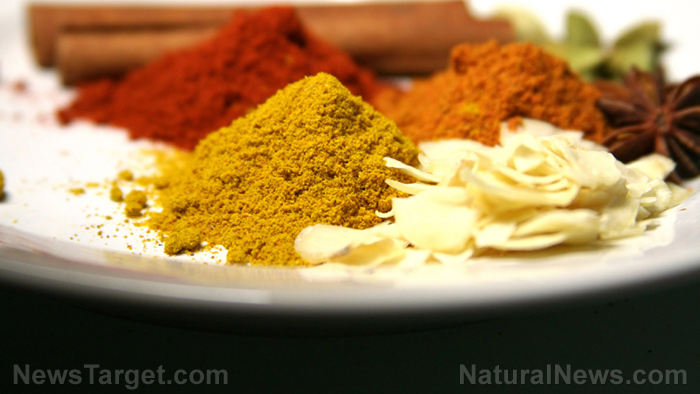Modern science uncovers the secrets behind ancient herb tarragon’s healing prowess
11/28/2024 / By Olivia Cook

Tarragon might already have a place in your spice rack as a tangy, aromatic addition to salads, sauces and soups. But beyond its culinary uses, tarragon holds a treasure trove of benefits. This humble herb has been used in traditional medicine for everything from soothing digestive discomfort to promoting restful sleep. It’s not just folklore – modern science is starting to uncover the secrets behind tarragon’s extraordinary potential.
In fact, a study about tarragon’s phytochemistry and biological activities has been published in Frontiers in Pharmacology. It tackles the things that makes this plant a gem in areas like inflammation control, infection prevention and even mood enhancement.
Tarragon’s phytochemicals
Tarragon’s appeal to researchers stems from its complex and variable chemistry. The plant’s aromatic and therapeutic properties are tied to its rich blend of bioactive compounds, including:
Alkamides. Found in the aerial parts of tarragon, compounds, like neopellitorines A and B and pellitorine, are of special interest for their potential to help fine-tine immune responses and provide natural analgesic (pain-relieving) effects.
Coumarins. These compounds, mainly herniarin, as well as artemidine, capillarin, dracumerin, esculetin, esculin, scoparone and scopoletin, are noted for their roles in regulating blood clotting and reducing inflammation. Coumarins in tarragon may also have calming effects – making them relevant to stress-related conditions.
Essential oil components. The active compounds in tarragon essential oil include the following:
- Estragole (as much as almost 88.5 percent in some varieties). This compound provides the sweet, anise-like fragrance of tarragon. It is also linked to anti-inflammatory and antimicrobial properties.
- Z-beta-ocimene (up to almost 8 percent) and E-beta-ocimene (up to almost 6 percent). These compounds add floral and citrusy notes to the herb’s aroma while contributing antioxidant and potential antimicrobial benefits.
- Terpinolene (up to almost 5 percent). Known for its fresh, herbal scent, this compound has demonstrated antioxidant activity and may help protect cells from oxidative damage.
- Limonene (up to nearly 3.5 percent). With its bright, citrusy aroma, limonene has been frequently studied for its potential anti-inflammatory and stress-reducing effects.
Flavonoids. Flavonoids in tarragon, such as isorhamnetin, kaempferol, luteolin, quercetin and their glycosides, help protect cells from oxidative damage. Additional flavonoids, like naringenin and pinocembrin, contribute to its anti-inflammatory and heart-protective properties.
Phenolic acids. These compounds, mainly caffeic acid, chlorogenic acid and vanillic acid, also serve as potent antioxidants. These acids also help reduce inflammation and may support cardiovascular health. Just one tablespoon (1.8 grams) of dried tarragon leaves provides a range of minerals and vitamins, including:
Minerals. Calcium, iron, manganese, magnesium, phosphorus and potassium are all present in trace amounts. For instance, manganese (6 percent of the daily value or DV) supports brain health and reduces oxidative stress, while iron (3 percent of the DV) is essential for oxygen transport in the blood – helping to combat fatigue. Potassium (1 percent of the DV) is vital for maintaining healthy heart, muscle and nerve function
Vitamins. Tarragon delivers vitamins A, C and several B vitamins, such as riboflavin (B2), niacin (B3), pyridoxine (B6) and folate (B9) – all of which are important for cell health, energy production and immune function. Though the amounts of these nutrients may seem modest, the cumulative effect of incorporating tarragon into your diet could still support overall health.
Tarragon’s health benefits
Scientific research suggests that tarragon may have wide-ranging benefits. In traditional medicine, it is used to treat digestion problems, poor appetite, water retention and toothache. In foods and beverages, tarragon is used as a culinary herb. (Related: Tarragon: Versatile ancient herb with science-backed health benefits.)
Anti-inflammatory and analgesic benefit
Studies in mice published in Pharmaceutical Biology showed that extracts from Artemesia dracunculus reduced swelling caused by an irritant, like xylene – a chemical used in lab experiments. Tarragon extracts also decrease the production of substances that make inflammation worse, such as reactive oxygen species (ROS) and inflammatory proteins, like tumor necrosis factor-alpha (TNF-alpha).
Antibacterial and antifungal properties
The antimicrobial effects of tarragon are largely attributed to its phytochemicals, including essential oil components, like estragole, limonene and terpinolene. These compounds disrupt microbial cell membranes, interfere with enzyme functions and produce oxidative stress in pathogens. Meanwhile, flavonoids and phenolic acids contribute through antioxidant and anti-inflammatory pathways – enhancing tarragon’s overall antimicrobial efficacy.
Mood-boosting potential
In animal tests published in Research in Pharmaceutical Sciences, tarragon extracts reduced the time spent immobile during stress-related challenges like swim tests – suggesting the herb helps reduce feelings of helplessness.
A study published in the Zeitschrift fur Naturforschung, C, Journal of Biosciences indicates that tarragon’s phenolic compounds may also lower stress-related inflammation and slightly block enzymes, like human monoamine oxidase A (hMAO-A) and hMAO-B, that are linked to mood regulation.
Antioxidant effects
Tarragon’s ability to protect cells from damage comes from its natural chemicals – flavonoids and phenolic compounds, which act as shields against harmful molecules called free radicals.
In scientific tests published in Avicenna Journal of Phytomedicine, tarragon reduced free radicals, like DPPH (2, 2-diphenyl-1-picrylhydrazyl) and ABTS (2, 20-azino-bis (3-ethylbenzothiazoline-6-sulfonic acid)) – chemical troublemakers that can damage cells over time. This antioxidant action may lower the risk of diseases, like heart disease, and help the body repair itself from daily wear and tear.
Antiprotozoal activity
A study published in the Journal of Parasite Diseases suggested that the time-dependent improvement of the efficacy of the bioactive compounds in tarragon extracts can effectively inhibit parasite growth – making it a promising candidate for the treatment of leishmaniasis. This parasitic disease, caused by Leishmania protozoa in the tropical and subtropical regions, can lead to serious skin and organ damage.
According to Iranian scientists involved in the study, the hydro-ethanolic extract of tarragon likely works by disrupting the protozoan’s cellular functions. Key bioactive compounds, including flavonoids and phenolic acids, demonstrated their ability to generate oxidative stress in pathogens and compromise their metabolism; interfere with the structural integrity of the pathogen’s cellular membranes; and modulate immune responses to target and eliminate parasitic infections.
Antitumor activity
In a study published in the Journal of Medicinal Food, tarragon’s natural phytocompounds like alkamides and polyphenols, have shown the ability to slow down the growth of cancer cells in the lab. For example, it stopped the growth of mouse lymphoma cells. While these findings are preliminary, they point to tarragon’s potential in cancer prevention or treatment.
Carbonic anhydrase inhibition
Tarragon has compounds that block carbonic anhydrase – an enzyme that helps regulate pH (acid levels) in the body. This activity could be useful in conditions, like glaucoma (high pressure in the eyes) or epilepsy.
Hepatoprotective effects
Tarragon seems to help the liver function well to detoxify the body. Tarragon lowers harmful enzymes, like alanine transaminase (ALT) and aspartate transaminase (AST) that indicate liver damage. It also boosts beneficial proteins and reduces harmful byproducts in the liver – making tarragon a promising option for supporting liver health, especially in cases of mild damage or stress on the organ.
Hypoglycemic properties
A randomized controlled trial published in the Journal of Medicinal Food has shown that for people dealing with high blood sugar or diabetes, tarragon may help reduce glycated hemoglobin (HbA1c). It also improves cholesterol levels – raising high-density lipoprotein or HDL (good cholesterol) and lowering blood pressure.
Immune system support
Data from a study in Avicenna Journal of Phytomedicine has shown that tarragon reduces levels of interleukin-17 (IL-17) and cytokine interferon-gamma (IFN-?) – proteins that can trigger excessive immune responses in conditions like autoimmunity. Additionally, it makes macrophages (cells that “eat” harmful invaders) more effective.
In animals, tarragon helps increase white blood cells, like neutrophils, which fight infections, while controlling lymphocytes that can overreact and cause problems.
Thyroid health support
Tarragon helps your thyroid control your metabolism by raising levels of important thyroid hormones T3 and T4, while lowering TSH, which can spike during thyroid issues. It also boosts antioxidants like glutathione – protecting thyroid tissues from damage.
Read more stories like this at Herbs.news.
Watch this video about 10 health benefits of tarragon.
This video is from the Daily Videos channel on Brighteon.com.
More related stories:
Prepper pharmacy: 17 Medicinal plants you can grow indoors year-round.
10 Best herbs to plant on your kitchen windowsill.
Tarragon and its many surprising health benefits.
Sources include:
Submit a correction >>
Tagged Under:
alternative medicine, anticancer, antioxidants, Antiparasitic, antitumor, blood sugar, food cures, food is medicine, functional food, herbal medicine, Herbs, immune system, infections, liver health, mental health, natural antibiotics, natural cures, natural health, natural medicine, natural remedies, Naturopathy, phytonutrients, tarragon, thyroid health
This article may contain statements that reflect the opinion of the author





















